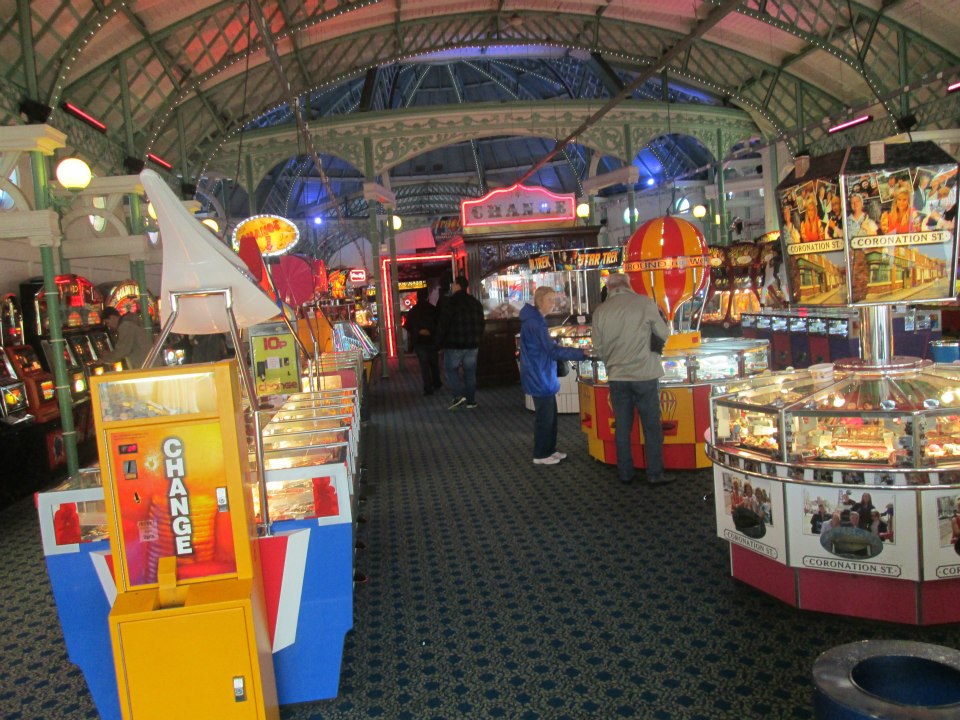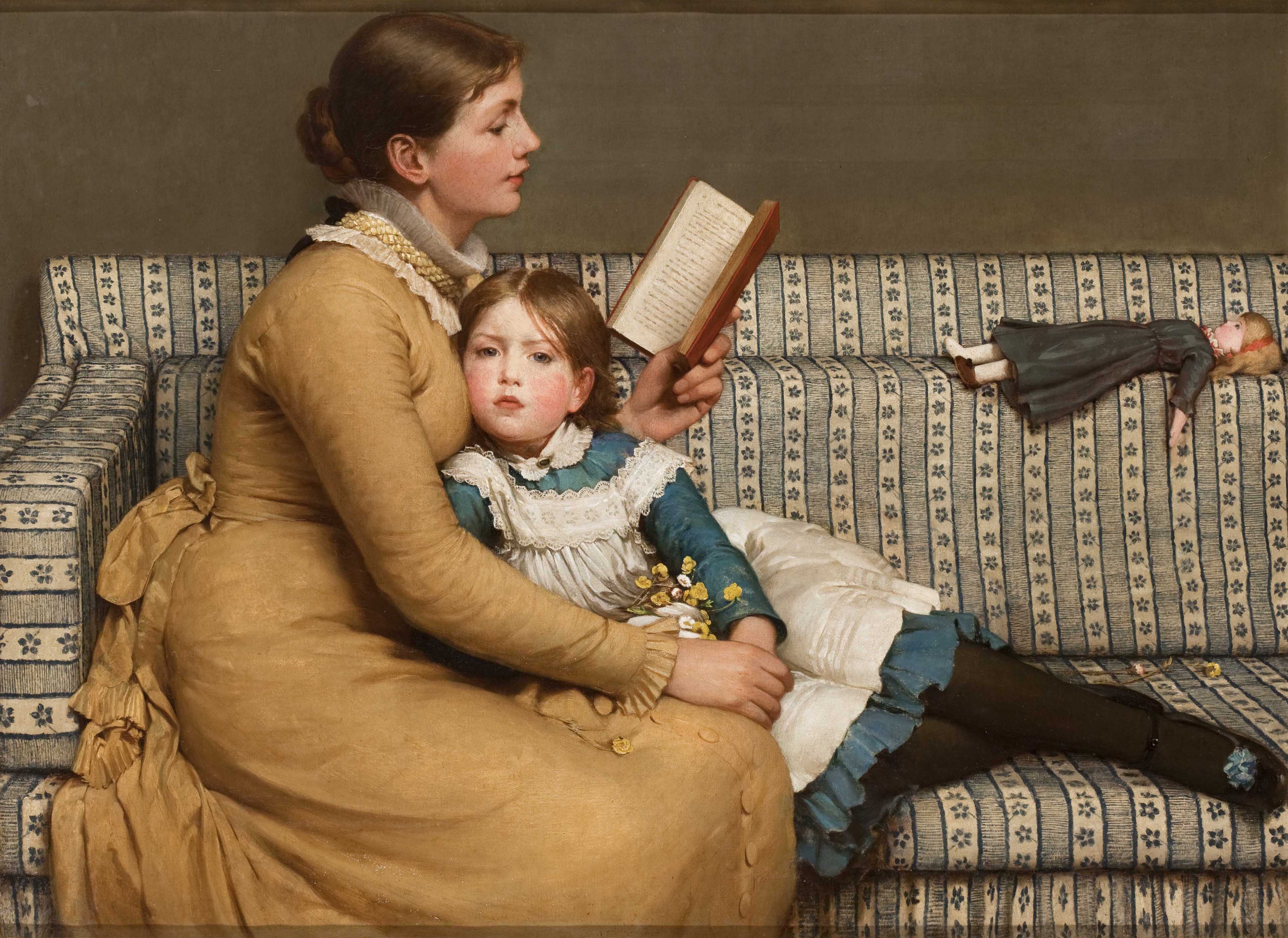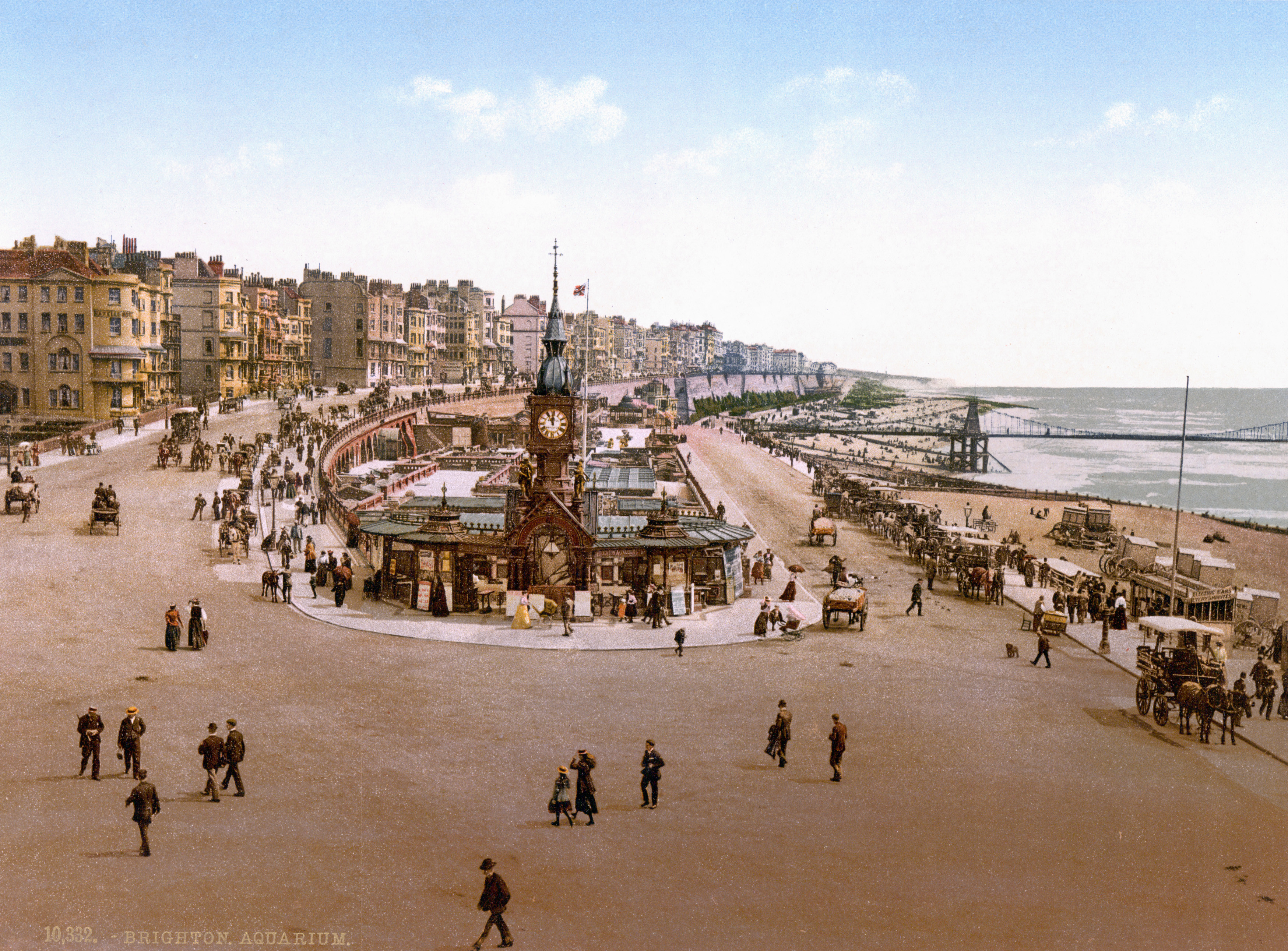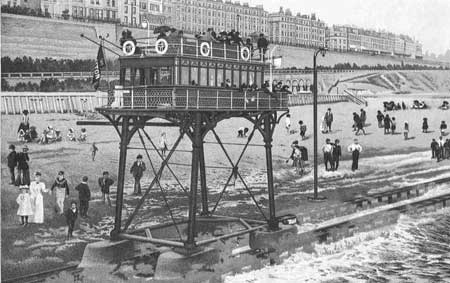|
Royal Suspension Chain Pier
The Royal Suspension Chain Pier was the first major pier built in Brighton, England. Opened on 25 November 1823, it was destroyed during a storm on 4 December 1896. History Generally known as the ''Chain Pier'', it was designed by Captain Samuel Brown , with construction starting on 18 September 1822 and completing in September 1823, opening on 25 November 1823. Brown had completed the Trinity Chain Pier in Edinburgh in 1821. The pier was primarily intended as a landing stage for packet boats to Dieppe, France, but it also featured a small number of attractions including a camera obscura. An esplanade with an entrance toll-booth controlled access to the pier which was roughly in line with the New Steine. Turner and Constable both made paintings of the pier, King William IV landed on it, and it was even the subject of a song. The Chain Pier co-existed with the later West Pier, but a condition to build the Palace Pier was that the builders would dismantle the Chain Pier. T ... [...More Info...] [...Related Items...] OR: [Wikipedia] [Google] [Baidu] |
English Channel
The English Channel, also known as the Channel, is an arm of the Atlantic Ocean that separates Southern England from northern France. It links to the southern part of the North Sea by the Strait of Dover at its northeastern end. It is the busiest Sea lane, shipping area in the world. It is about long and varies in width from at its widest to at its narrowest in the Strait of Dover."English Channel". ''The Columbia Encyclopedia'', 2004. It is the smallest of the shallow seas around the continental shelf of Europe, covering an area of some . The Channel aided the United Kingdom in becoming a naval superpower, serving as a natural defence against invasions, such as in the Napoleonic Wars and in the World War II, Second World War. The northern, English coast of the Channel is more populous than the southern, French coast. The major languages spoken in this region are English language, English and French language, French. Names Roman historiography, Roman sources as (or , ... [...More Info...] [...Related Items...] OR: [Wikipedia] [Google] [Baidu] |
Brighton Pier
The Brighton Palace Pier, commonly known as Brighton Pier or the Palace Pier, is a Grade II* listed pleasure pier in Brighton, England, located in the city centre opposite the Old Steine. Established in 1899, it was the third pier to be constructed in Brighton after the Royal Suspension Chain Pier and the West Pier, but is now the only one still in operation. It is managed and operated by the Eclectic Bar Group. The Palace Pier was intended as a replacement for the Chain Pier, which collapsed in 1896 during construction of the new pier. It quickly became popular, and had become a frequently-visited theatre and entertainment venue by 1911. Aside from closures owing to war, it continued to hold regular entertainment up to the 1970s. The theatre was damaged in 1973 and following a buy-out was demolished in 1986, changing the pier's character from seaside entertainment to an amusement park, with various fairground rides and roller coasters. The pier remains popular with the p ... [...More Info...] [...Related Items...] OR: [Wikipedia] [Google] [Baidu] |
Piers In Sussex
{{disambiguation ...
Piers may refer to: * Pier, a raised structure over a body of water * Pier (architecture), an architectural support * Piers (name), a given name and surname (including lists of people with the name) * Piers baronets, two titles, in the baronetages of Ireland and Nova Scotia * Piers Island, British Columbia, Canada * PIERS: The Port Import/Export Reporting Service, an American trade intelligence company See also * Pier (other) * Pierres (other) * Pierse * Pierce (other) * Peirse (other) Peirse may refer to: People with the surname *Henry Peirse (1750s–1824), English politician *Richard Peirse (Royal Navy officer) (1860–1940), English Royal Navy officer *Richard Peirse (1892–1970), English RAF commander *Richard Peirse (RAF o ... [...More Info...] [...Related Items...] OR: [Wikipedia] [Google] [Baidu] |
List Of Piers In The United Kingdom
This is a list of extant and former coastal piers in the United Kingdom and Isle of Man and piers on the river Thames. Coastal piers England Scotland Wales Isle of Man Piers in London on the River Thames Former piers See also * List of piers * National Piers Society References {{Piers in the United Kingdom Lists of buildings and structures in the United Kingdom, Piers Piers in the United Kingdom, *List ... [...More Info...] [...Related Items...] OR: [Wikipedia] [Google] [Baidu] |
National Piers Society
The National Piers Society (NPS) is a registered charity in the United Kingdom dedicated to promoting and sustaining interest in the preservation and continued enjoyment of seaside piers. It was founded in 1979, with Sir John Betjeman as the first Honorary President. with Tim Mickleburgh (Chair 1995-2003) as Honorary Vice President. The NPS became a registered charity in 1999, and quarterly magazines have been published since 1987. The society also Lobbying, lobbies heritage bodies, lottery boards, local authorities and the media on pier issues. In 2014 it worked with English Heritage to bring out the book ''British Seaside Piers''. The Annual General Meeting takes place at a different resort each year, beginning in 1983. The meetings usually include private tours of nearby piers. In addition to establishing regional branches, the society is working to create a National Piers Museum. The NPS maintains links with the relevant trade association, thBritish Association of Leisure ... [...More Info...] [...Related Items...] OR: [Wikipedia] [Google] [Baidu] |
Brighton Museum & Art Gallery
Brighton Museum & Art Gallery is a municipally-owned public museum and art gallery in the city of Brighton and Hove in the South East of England. It is part of Brighton & Hove Museums. It costs £9.50 for a yearly pass, discounted to £7 for Brighton and Hove residents and students at local universities. History The building which houses the collection is part of the Royal Pavilion Estate and was originally built for the Prince of Wales, later George IV and completed in 1805. It was initially intended as a tennis court but had never been finished, and later served as cavalry barracks.''Catalogue of Paintings in Oil Before 1837'' (Brighton Museum and Art Gallery, 1964) After the death of George IV in 1830, his successor King William IV also stayed in the Pavilion on his visits to Brighton. However, after Queen Victoria's last visit to Brighton in 1845, the Government planned to sell the building and grounds. The Brighton Commissioners and the Brighton Vestry successfully pe ... [...More Info...] [...Related Items...] OR: [Wikipedia] [Google] [Baidu] |
The Chain Pier, Brighton (Turner)
''The Chain Pier, Brighton'' is an 1828 landscape painting by the British artist J.M.W. Turner featuring a view of the sea at the restort town of Brighton in Southern England, dominated by the Royal Suspension Chain Pier which had opened five years earlier. The work was originally produced for the art collector Earl of Egremont's property at Petworth House where it was designed as one of four landscapes intended to fit under full-length portraits, explaining its unusual width. Egremont had been one of the investors in the construction of the pier. The work was part of the Turner Bequest of 1856 and was in the National Gallery until 1906 before it was transferred to the Tate Britain. Turner's contemporary John Constable had produced his own painting '' Chain Pier, Brighton'' the previous year, which is also now in the Tate.Thornes p.134-35 See also * List of paintings by J. M. W. Turner A list is a set of discrete items of information collected and set forth in some format ... [...More Info...] [...Related Items...] OR: [Wikipedia] [Google] [Baidu] |
Chain Pier, Brighton (painting)
''Chain Pier, Brighton'' is a landscape painting by the British artist John Constable. One of his "six footers", it was exhibited at the Royal Academy's 1827 Summer Exhibition. It depicts the recently constructed Brighton Chain Pier in the resort town of Brighton on the southern coast of England. The Pier was opened in 1823 and remained a prominent feature of the Brighton seafront until it collapsed in 1896. It was the largest and most important work from Constable's visits to Brighton where his wife went to recover her health. With a storm about to break it shows the bustling activity on the beach with the new hotels and wealthy residences in the background. Today it is part of the collection of the Tate Britain in London London is the Capital city, capital and List of urban areas in the United Kingdom, largest city of both England and the United Kingdom, with a population of in . London metropolitan area, Its wider metropolitan area is the largest in Wester ... having ... [...More Info...] [...Related Items...] OR: [Wikipedia] [Google] [Baidu] |
Brighton Aquarium
SEA LIFE Brighton, known originally as Brighton Aquarium and then from 1969 until 1991 as Brighton Aquarium and Dolphinarium, is an aquarium attraction in Brighton, part of the English seaside city of Brighton and Hove. Opened as Brighton Aquarium in 1872, it is the oldest continuously operating aquarium in the world, and the main tank was the largest in the world at the time. The attraction was bought by SEA LIFE in 1991. Occupying a prominent position on Brighton seafront, the aquarium was immediately popular among fashionable visitors when it opened and continued to be "one of Brighton's great tourist attractions" for many years afterwards, despite periods of decline. Its exterior was substantially rebuilt in a modern style in the 1920s, and new attractions were added to the roof terrace, but the High Victorian Gothic interior remains. The building was requisitioned during World War II and many changes were made after the war, including the introduction of a motor museum, nightc ... [...More Info...] [...Related Items...] OR: [Wikipedia] [Google] [Baidu] |
Photochrom
Photochrom, Fotochrom, Photochrome or the Aäc process is a process of hand-colouring of photographs, hand-colouring photographs from a single black-and-white photographic negative, negative with subsequent photographic transfer onto Lithography, lithographic printing plates. The process is a photographic variant of chromolithography (color lithography). Because no color information was preserved in the photographic process, the photographer would make detailed notes on the colors within the scene and use the notes to hand paint the negative before transferring the image through Color gel, colored gels onto the printing plates. History The process was invented in the 1880s by Hans Jakob Schmid (1856–1924), an employee of the Swiss company Orell Gessner Füssli—a printing firm whose history began in the 16th century. Füssli founded the stock company Photochrom Zürich (later Photoglob Zürich, Photoglob Zürich AG) as the business vehicle for the commercial exploitation of th ... [...More Info...] [...Related Items...] OR: [Wikipedia] [Google] [Baidu] |
Brighton And Rottingdean Seashore Electric Railway
The Brighton and Rottingdean Seashore Electric Railway was a unique coastline railway in Brighton, England, that ran through the shallow coastal waters of the English Channel between 1896 and 1901. It was designed by Magnus Volk to extend his Volk's Electric Railway from its terminus in Paston Place to the village of Rottingdean and avoid difficult terrain. While the railway was popular and carried tens of thousands of passengers, it was ultimately abandoned to make room for new sea defences, and Volk was unable to raise the funds to construct a replacement. Background and construction Magnus Volk, its owner, designer and engineer, had already been successful with the more conventional Volk's Electric Railway, which had then not been extended east of Paston Place. With unfavourable geography in that area, Volk decided to construct a line through the surf from a pier at Paston Place to one at Rottingdean. This was also home to Volk's Seaplane Station which was used by his so ... [...More Info...] [...Related Items...] OR: [Wikipedia] [Google] [Baidu] |
West Pier
The West Pier is a ruined pier in Brighton, England. Designed by Eugenius Birch and opening in 1866, it was the first pier to be Grade I listed in England but has become increasingly derelict since its closure to the public in 1975. only a partial metal framework remains. The pier was constructed during a boom in pleasure pier building in the 1860s, and was designed to attract tourists to Brighton. It was the town's second pier, joining the Royal Suspension Chain Pier that opened in 1823. The West Pier was extended in 1893, and a concert hall was added in 1916. The pier reached its peak attendance at this time, with 2 million visitors between 1918 and 1919. Its popularity began to decline after World War II, and concerts were replaced by a funfair and tearoom. A local company took over ownership of the pier in 1965, but could not meet the increasing costs of maintenance and filed for bankruptcy. The pier closed to the public in 1975 and fell into disrepair and gradually ... [...More Info...] [...Related Items...] OR: [Wikipedia] [Google] [Baidu] |








